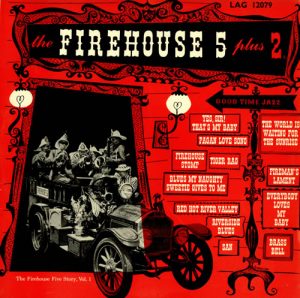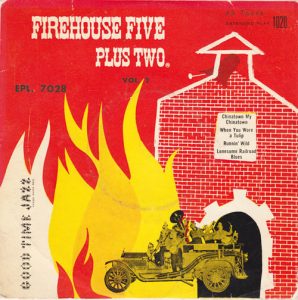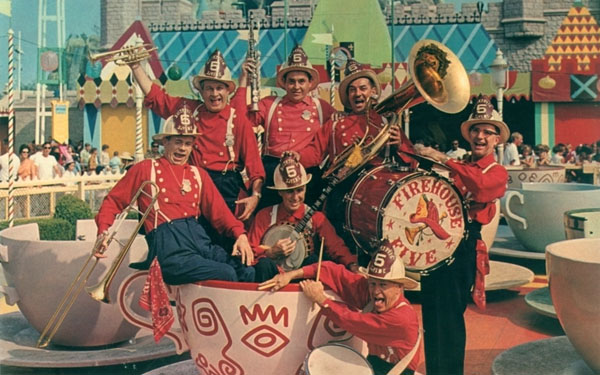
In the mid-1940s, a group of Walt Disney animators, artists, writers and musicians who loved jazz and collected records would gather around a phonograph at the studio during lunch breaks and play along with the records.
“Then one day the phonograph broke down right in the middle of ‘Royal Garden Blues.’ Undaunted, we kept right on playing and found to our amazement that we sounded pretty good all by ourselves!” remembered band chief Ward Kimball.
Originally, the band was called the “Huggageedy 8”. Kimball explained: “That was the sound of my old Model-T Ford. Huggageddy-huggageddy-huggageddy.”
 Then it was called the “San Gabriel Valley Blue Blowers.” Laughed Kimball, “San Gabriel is a little town near Pasadena where I live. So if it didn’t turn out, the boys figured they’d let them come after me! But it went okay and pretty soon we began to feel like musicians.”
Then it was called the “San Gabriel Valley Blue Blowers.” Laughed Kimball, “San Gabriel is a little town near Pasadena where I live. So if it didn’t turn out, the boys figured they’d let them come after me! But it went okay and pretty soon we began to feel like musicians.”
The final name was a result of Kimball getting a 1914 American La France fire truck that took six months to clean and fix. In addition he got some red fireman shirts, white suspenders and authentic leather fire helmets for a trip with the band down to San Diego as part of an event of the California Horseless Carriage Club in 1948.
It was a 250-mile round trip. While aboard the fire engine, the band played in the streets, serenaded firehouses along the way, stopped at schools and disrupted classrooms when children ran out to listen to them, and generally caused all sorts of snarled traffic challenges.
Why were they called “Firehouse Five Plus Two”? Kimball often gave coy answers (he told Groucho Marx on the March 18, 1954 episode of “You Bet Your Life” game show “because there are seven of us”) but he did tell me in an interview at the Disney Institute: “Firehouse Five was the original name and we thought it was great but in order to let people know they were going to get a seven piece band instead of five, we’d say ‘plus two!’”
Over the course of a little over two decades, nineteen different men were members of the Firehouse Five Plus Two band at various times:

Danny Alguire (cornet)
Ralph Ball (tuba)
George Bruns (tuba)
K.O. Eckland (piano)
Eddie Forest (drums)
Harper Goff (banjo)
Jerry Hamm (drums)
Ward Kimball (trombone)
Don Kinch (trumpet/tuba)
Johnny Lucas (trumpet)
Jim MacDonald (drums)
Clarke Mallery (clarinet)
Monte Mountjoy (drums)
Bill Newman (banjo)
Ed Penner (sax/tuba)
George Probert (sax)
Dick Roberts (banjo)
Tom Sharpsteen (clarinet)
Frank Thomas (piano)
Disney artist Hank Porter was asked by Ward Kimball to join the group as a piano player. Porter had played the piano ever since he was a child and by all accounts was a very, very accomplished player. For whatever reason, Porter declined the offer.
One of the things that made the band unique was having a fire siren and alarm bell in their music like Firehouse Stomp, the band’s theme song adapted from the popular march Under the Double Eagle. Kimball insisted it was “not for corn but for fun and for what it adds to the music.”
“Walt always liked music and he was very proud of us. He couldn’t get over the fact that some of the guys who worked for him as animators and artists were all of a sudden the toast of the music world. He didn’t get mad if we took some time off once in awhile but we made it a rule not to take advantage of the situation,” remarked Kimball.
The band played for Bing Crosby at his annual Pebble Beach Golf Tournament which led to four appearances on his radio show.
Television also welcomed the firemen and they appeared on The Ed Wynn Show, The Milton Berle Show, the Make Believe Ballroom and the very first Disney television special, One Hour in Wonderland in 1950.
They also appeared in two feature films, Hit Parade of 1951, a B musical from Republic and Grounds for Marriage, a 1951 MGM comedy, where Van Johnson and Kathryn Grayson go to the Firehouse Club to hear the band play “Tiger Rag”. Here’s a clip from that:
In 1950 the band made a series of Snader Telecriptions (fillers for TV when shows ended early). These films show the band in a firehouse setting and feature Kimball and Harper Goff. They did The Lawrence Welk Show and made a memorable appearance on Bobby Troup’s Stars of Jazz show in 1958.
On opening day of Disneyland on July 17, 1955, the band appeared at the firehouse on Main Street for the ceremonies. “Walt told us to wander around the park and play wherever there was a crowd. We were the first mobile band at Disneyland,” remembered Kimball in a 1984 interview.
In 1956 the band appeared on the original Mickey Mouse Club where the band joined the Mouseketeers for “I Want To Be a Fireman” and “Tiger Rag” with Mousketeer Cubby O’Brien sitting in on drums.
Firehouse Five Plus Two recorded 150 tunes for a dozen albums that fortunately are currently available on CD. The band appealed to the general public, but they were also a huge hit with jazz fans, playing to large crowds at the Frank Bull-Gene Norman “Dixieland Jubilees” at the Shrine Auditorium in Los Angeles.
In the early 1950s, they made several journeys north to play at Hambone Kelly’s, Club Hangover and at the old Opera House in Virginia City, Nevada. Often jazz greats joined the performances as featured guests.
Brick Mack, Dick Shaw and Virgil Partch held a party on the last Red Car ride from Los Angeles to Long Beach while they and their guests danced to the music of Ward Kimball’s Firehouse Five Plus Two.
An animated version of the band appeared in the 1953 Goofy short How To Dance. The band received an homage in the ending of the 2009 Disney film The Princess and the Frog, with the jazz-playing alligator Louis now belonging to a group called “The Firefly Five Plus Lou”.

“Firehouse Five Plus Two At Disneyland”, was recorded on July 27 and 28 of 1962 at the Golden Horseshoe in Frontierland, a regular venue for the band in the summertime. Besides the music are samples of Kimball’s announcements like: “We’re going to take a 15 minute break. So you have time to go on all the Rides!” The band also took part in many of the Dixieland at Disneyland festivals, sharing the bill with the likes of greats like Louis Armstrong.
Although the band’s last official gig was an auto show at the Anaheim Convention Center in 1971, few people realize that the band did get together nine years later to make one more final appearance in the 1980 Tournament of Roses Parade where they had performed thirty years before as the first jazz band ever to be in the parade.


 Jim Korkis is an internationally respected animation historian who in recent years has devoted his attention to the many worlds of Disney. He was a columnist for a variety of animation magazines. With his former writing partner, John Cawley, he authored several animation related books including The Encyclopedia of Cartoon Superstars, How to Create Animation, Cartoon Confidential and Get Animated’s Animation Art Buyer’s Guide. He taught animation classes at the Disney Institute in Florida as well as instructing classes on acting and animation history for Disney Feature Animation: Florida.
Jim Korkis is an internationally respected animation historian who in recent years has devoted his attention to the many worlds of Disney. He was a columnist for a variety of animation magazines. With his former writing partner, John Cawley, he authored several animation related books including The Encyclopedia of Cartoon Superstars, How to Create Animation, Cartoon Confidential and Get Animated’s Animation Art Buyer’s Guide. He taught animation classes at the Disney Institute in Florida as well as instructing classes on acting and animation history for Disney Feature Animation: Florida.




















































Had I known this earlier, I would have picked up every Firehouse Five Plus Two record I came across, back when 78s were plentiful and cheap in the 1980s and 1990s. Instead, I only have a couple in my collection. They have a very unique label design, which isn’t surprising…
Jane.. THere’s still antique shops like one where I am where they hgave many 78s….a modern incarnaiton of the Five stills apepars at Disneyland
And weren’t those 78s far better to listen to (in the 1980s and 90s) than the then current songs which passed for music hits..:)
Sure you know, but most of their
Record albums from 50’s were put
On CD’s in the 90’s. I like FF Story.
Most were just fine with notes.
I found a copy of one of those LP’s a while back for my collection!
As a follow-up to my original post, I stumbled across the 1955-remastered LP of 1949-50 recordings, as pictured above, issued under the original catalog number (L-12010). It was in a pile of LPs I picked up at a Macon, GA thrift store in 1999 and promptly forgot until tonight.
I remember a video series from the 1990s called I Love Toy Trains which featured. Ward Kimball and his massive toy train collection that he had with background music by The Firehouse Five Plus Two. And that’s the final known video recording of Ward Kimball until his death in 2002. Currently there’s a locomotive at the Disneyland Railroad named after Ward Kimball at Disneyland with a silhouette of Jiminy Cricket on the light box near the smokestack of the locomotive.
The Mickey Mouse Club “Tiger Rag” performance was featured in “At Home With Donald Duck”, a “Disneyland”/”World of Color” episode that was briefly available on an RCA Selectavision disc.
After unjustly punishing the nephews (the short “Donald’s Happy Birthday”), Donald makes up for it by trotting out his projector and a bunch of cartoons. At one point the nephews turn on the TV and we get the original MMC title sequence in color, followed by “Tiger Rag” in tinted B&W.
The direct-to-video “Mickey’s Once Upon a Christmas” included an animated “Firehouse 5”, with fleeting glimpses of vague caricatures.
I have a couple of their 78s plus the album on the Good Time Jazz label L-12012. Anyone one know who spoke the Chinese (I assume) opening to Chinatown, my Chinatown? It was translated on the liner notes as, “We are now most happy to present the distinguished artist Harper Goff, who will favor us with a delightful banjo number.”
https://www.youtube.com/watch?v=1en9-L3EO-g
My great uncle, Jerry Hamm, played drums in the band for a spell. He passed away in the 60s, but I get to see him once or twice each year around Easter when the movie “The Egg and I” with Claudette Colbert, Fred MacMurray, and Ma and Pa Kettle airs on TV. Jerry played the drums during the barn dance scene. It’s always good to see his smiling face while watching the movie. Interestingly, I live close to Vashon Island these days, which is the location of the chicken farm in Betty MacDonald’s original story.
Ward told me that since Jerry was never, officially, a member of the band, that, for the Goofy Learns To Dance cartoon, he drew in Jerry as the drummer for the animator . Ward didn’t have time to do the animation, so he drew out how he wanted everybody to look. I have The Egg And I movie, so I’m going to watch it again for the barn dance scene.
Google: The History Of The Firehouse Five Plus Two, by Robert Butler. Thanks for the Jerry Hamm info.
Absolutely my favorite musical group and enjoy playing trombone along with FHF+2 CDs.
Met the Great Ward Kimball in 1999 and enjoyed telling him how much I admired his career accomplishments and great music.
Ward was as humble as he was great and a living link to a colorful era. Ward gave me a privileged and personal 1-1/2 hour tour of his backyard railroad, railroad depot, toy store, model train buildings, and firehouse with his fire engines. I will treasure this time with Ward forever ! Truly a mountain top experience ! Ward donated generously of his narrow gage train collection to the Orange Empire Railroad Museum where he also conducted lectures and financed the storage facilities for his trains. The OERM folks worshiped Ward and were blown away when I told them about the wonderful tour that Ward conducted for me in his back yard playground ! Would love to roll back the clock to the mid 1950s and meet the FHF+2 members, see them at work in the Disney Studios, and hear them play their fabulous music. Read all I can about Disney animation and Ward’s animations and the pranks pulled on his fellow animators had to be absolutely choice !!
My Aunts sister was married to a man who worked for Disney many years ago. I have a cartoon picture of the. Firehouse five, but not sure if it’s worth anything. It’s the band characters cut out and put on illustration board. Any idea?